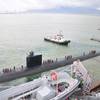The 70th session of the Marine Environment Protection Committee (MEPC) of the International Maritime Organization (IMO) concluded today (October 28) with a decision on defined tasks and timelines to reduce greenhouse gas (GHG) emissions from ships.
The agreed roadmap complements the decision to have a mandatory global GHG data collection system in place as of 2019. MEPC furthermore decided to have a global 0.5% sulphur limit in 2020 and a Nitrogen Emission Control Area (NECA) in the North Sea and Baltic Sea.
“These important decisions demonstrate the global leadership of IMO on regulation of ship emissions", said European Community Shipowners’ Associations (ECSA) Secretary General Patrick Verhoeven.
“The mandatory GHG data collection system will make it possible to define what will be the contribution of international shipping to the climate goals set by COP21 in Paris last year. The adoption of an initial strategy to meet the Paris targets is already planned for 2018 and an agreement on targets and measures, including an implementation plan, will come about in 2023 once real time data have been analysed."
"It is important that IMO Member States agreed that work on emission reductions and further measures will already start now, in parallel to the process of data collection and analysis. This way we do not loose time", he added.
On the decision to cap sulphur emissions by 2020, Patrick Verhoeven commented: “It is good news that IMO took a decision on the global deadline as shipowners need certainty. Year 2020 is tomorrow however, so we have to speed up work on implementation. In particular, we have to ensure that there is quality fuel available everywhere in the world and that adequate enforcement measures are in place to ensure a global level playing field”, he concluded.
Today’s decision on the roadmap for developing a comprehensive IMO strategy on reduction of GHG emissions is a logical follow-up to technical and operational measures taken earlier such as the Energy Efficiency Design Index (EEDI) and Ship Energy Efficiency Management Plan (SEEMP) adopted in 2011 to ensure that ships will be more CO2 efficient in the future.











